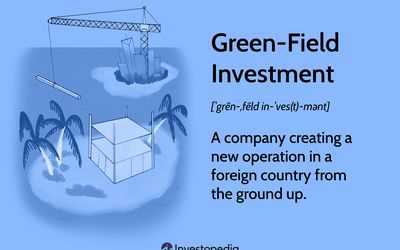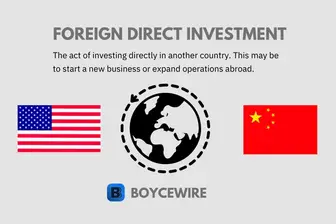What is Direct Investment?
Direct investment refers to the acquisition of a controlling interest in a company or business by an investor from another country. It involves the ownership and management of assets in a foreign country, with the aim of establishing a long-term presence and gaining a competitive advantage in the market.
Direct investment is different from portfolio investment, where investors buy stocks or bonds of foreign companies without seeking to gain control or influence over the management of the business. In direct investment, the investor seeks to actively participate in the management and decision-making processes of the foreign company.
Direct investment can bring several benefits to both the investor and the host country. For the investor, it provides opportunities for diversification, access to new markets, and potential for higher returns on investment. For the host country, it can stimulate economic growth, create jobs, transfer technology and skills, and enhance competitiveness.
However, direct investment also carries risks. Political instability, regulatory changes, economic downturns, and currency fluctuations can all affect the performance and profitability of direct investments. Therefore, it is important for investors to conduct thorough due diligence, assess the risks involved, and develop strategies to mitigate potential challenges.
Types of Direct Investment
Direct investment refers to the ownership or control of a company or asset by a foreign entity. There are several types of direct investment, each with its own characteristics and benefits. Here are some of the most common types:
1. Greenfield Investment
Greenfield investment involves the establishment of a new business or facility in a foreign country. This type of investment requires significant capital and involves building a new infrastructure from scratch. Greenfield investments are often seen as a long-term commitment and can provide the investor with full control over the operations and management of the business.
2. Mergers and Acquisitions
Mergers and acquisitions (M&A) involve the purchase or merger of an existing company in a foreign country. This type of direct investment allows the investor to quickly gain access to an established market, customer base, and distribution network. M&A can be a strategic move to expand market share, diversify product offerings, or gain a competitive advantage.
3. Joint Ventures

Joint ventures involve a partnership between a foreign investor and a local company or government entity. This type of direct investment allows for the sharing of resources, knowledge, and expertise. Joint ventures can be a way to navigate regulatory barriers, access local market knowledge, and share risks and rewards with a local partner.
4. Cross-Border Investments
Cross-border investments refer to the purchase of securities, such as stocks and bonds, in foreign companies. This type of direct investment allows investors to gain exposure to international markets and diversify their investment portfolios. Cross-border investments can be made through stock exchanges or over-the-counter markets.
5. Foreign Direct Investment (FDI)

Foreign direct investment refers to the investment made by a foreign entity in the form of equity or debt in a company located in another country. FDI can take various forms, including the establishment of subsidiaries or branches, the acquisition of shares, or the provision of loans. FDI is often driven by factors such as market access, cost advantages, and strategic considerations.
Examples of Direct Investment
Direct investment involves the acquisition of a controlling interest in a foreign company or the establishment of a new business venture in a foreign country. Here are some examples of direct investment:
| Example | Description |
|---|---|
| Foreign Direct Investment (FDI) | |
| Joint Ventures | Two companies from different countries decide to form a joint venture to enter a new market. For example, a technology company from the United States partners with a local company in India to develop and sell software products specifically for the Indian market. Both companies contribute capital, resources, and expertise to the joint venture. |
| Greenfield Investments | |
| Mergers and Acquisitions | A company from one country acquires another company in a different country. This can be a strategic move to expand into new markets, gain access to new technologies, or achieve cost synergies. For example, a pharmaceutical company from Germany acquires a biotech company in the United States to strengthen its research and development capabilities. |
These examples demonstrate the various ways in which direct investment can take place. Each type of direct investment has its own advantages and risks, and companies carefully evaluate the potential benefits before making investment decisions.
Benefits and Risks of Direct Investment
Direct investment can offer several benefits to investors. One of the main advantages is the potential for higher returns compared to other investment options. By directly investing in a specific company or project, investors have the opportunity to benefit from its success and growth.
Another benefit is the ability to have more control and influence over the investment. Unlike indirect investment options like mutual funds or exchange-traded funds (ETFs), direct investment allows investors to make decisions based on their own research and analysis.
Direct investment also provides the opportunity for diversification. By investing in different companies or industries, investors can spread their risk and potentially minimize losses. This can be especially beneficial in volatile markets or during economic downturns.
However, direct investment also comes with its own set of risks. One of the main risks is the potential for loss of capital. If the invested company or project fails, investors may lose their entire investment. This risk is higher compared to indirect investment options, where losses are typically spread across a portfolio of investments.
Another risk is the lack of liquidity. Direct investments are often illiquid, meaning that it can be difficult to sell or exit the investment quickly. This can limit an investor’s ability to access their funds when needed.
Additionally, direct investment requires a higher level of knowledge and expertise. Investors need to thoroughly research and understand the company or project they are investing in. This can be time-consuming and may require specialized knowledge in a particular industry.
Lastly, direct investment can be more susceptible to market fluctuations and economic conditions. Factors such as changes in interest rates, government regulations, or global events can significantly impact the performance of a direct investment.

Emily Bibb simplifies finance through bestselling books and articles, bridging complex concepts for everyday understanding. Engaging audiences via social media, she shares insights for financial success. Active in seminars and philanthropy, Bibb aims to create a more financially informed society, driven by her passion for empowering others.
